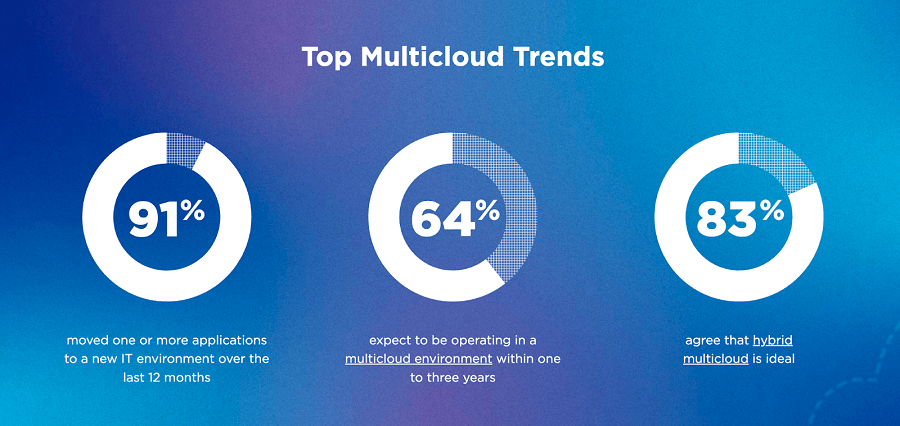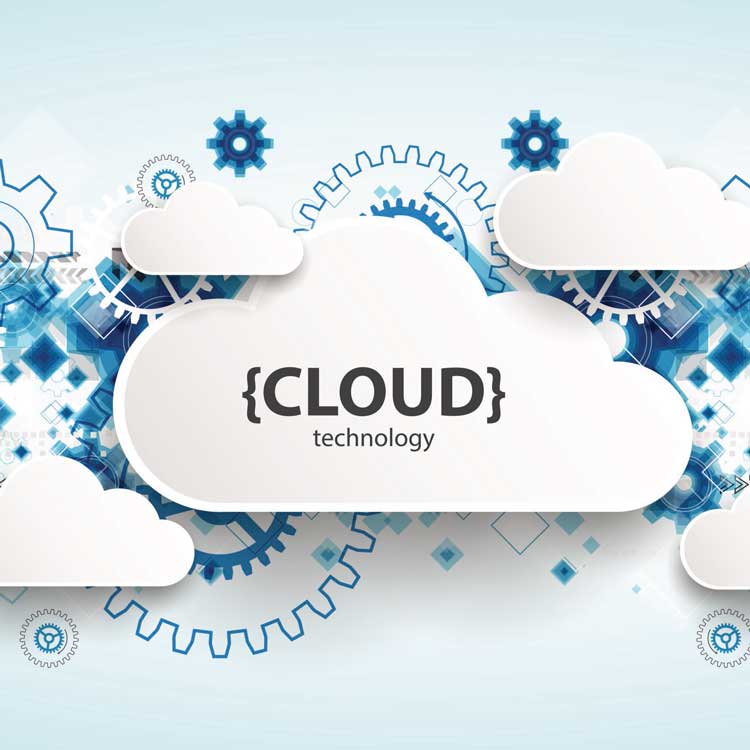The most common IT operating model worldwide is multicloud infrastructure that combines two or more public or private clouds, according to the Nutanix Fourth Annual Enterprise Cloud Index (ECI) study, published early 2022. That’s unlikely to change in the near future but other factors remain hard to pin down.
Research conducted by the U.K.’s Vanson Bourne for Nutanix determined that 36% of the 1,700 global, cross-industry respondents use multiple clouds today, outpacing those running traditional datacenters (22%). Nearly two-thirds (64%) expect to be running multicloud within three years.
Large enterprises with 5000-plus employees reported far greater adoption levels: 57% currently use multicloud and 80% expect to be using it within three years.
Private cloud-only usage rose slightly during the past year, from about 23% penetration in 2020 to 25% in 2021, representing the second most common deployment model.
Evolving Cloud Strategies and Motivators
The ECI research reflects a growing maturity in enterprise cloud decision-making. First, the data implies greater acceptance of the public cloud, both as a dynamic extension to private infrastructure and for bolstering key use cases like disaster recovery and remote work. On average, ECI respondent enterprises used 1.6 public clouds, up from 1.1 a year ago.
Second, enterprises are becoming more strategic in where they run their workloads, in large part due to the growing availability of cloud-native tools that enable dynamic infrastructure changes as requirements evolve. In this way, multicloud represents a macro shift from an all-or-nothing public cloud mindset to a cloud-smart approach that entails matching each workload to the best private or public infrastructure based on factors such as cost, performance requirements, security, compliance, and business continuity. For example, a far greater percentage of respondents identified the private cloud as best for running databases while the bigger group named public clouds as ideal for collaboration and content management applications.
Third, enterprises are citing more business reasons, rather than just technical motivations, for changing their IT models and relocating applications across infrastructures. The business-centric multicloud drivers cited most often were improving remote work and collaboration (40%), supporting customers better (36%), and strengthening business continuity (35%).
Finally, some enterprise motives for turning to a multicloud setup are fairly simple.
“Most organizations adopt a multicloud strategy out of a desire to avoid vendor lock-in or to take advantage of best-of-breed solutions,” wrote Michael Warrilow, VP Analyst, Gartner, in a “Smarter with Gartner” article. “We expect that most large organizations will continue to willfully pursue this approach.”
Steve McDowell, senior analyst at Moor Insights and Strategy, added that data protection use cases are helping drive multicloud adoption.
“Most organizations do touch the [public] cloud,” he said. “But that doesn’t mean that they’re running big apps there. There’s lot of data backup in the public cloud” contributing to multicloud growth, he said.
Two years of a COVID pandemic have put more pressure on IT leaders to keep their businesses running and growing. During this time, many IT leaders evolved from technology experts to important business decision makers.
“It has shone a light on the importance of IT’s ability to blend technology and operational excellence in service of employees and customers,” wrote Wendy M. Pfeiffer, chief information officer at Nutanix, in a blog post.
“It has shone a light on the imperative for open systems, resilient supply chains, and application mobility.”
Operations: Where Rubber Meets Road
Nearly all organizations (91%) surveyed for the 4th Annual ECI said they had moved one or more applications to a new IT environment in the 12 months prior. They cited security most often as the reason (41%), followed by performance (39%) and gaining better control of the application (38%). However, 80% of respondents also agreed that moving a workload to a different cloud platform can be costly and time-consuming.
Containers are gaining traction to help ease these app mobility difficulties: 82% of ECI respondents agreed that containers are important to their organizations today or will be within 12 months. Containers package an application and all its dependencies in a lightweight, uniform set of libraries and APIs as a standardized way to run that app in any cloud and move it around as needed. Gartner predicts that by 2023, 70% of global organizations will have more than two containerized applications in production, up from less than 20% in 2019.
Similarly, interoperability among multiple cloud environments is essential, though complexity persists. While most respondents using multicloud reported some level of interoperability between the clouds they use, most (87%) also said they need simpler management across different cloud platforms, tools, dashboards, and configuration methodologies.
“Managing multicloud is extremely complex and involves having to train people on new cloud tools,” said McDowell.
He underscored the importance of cloud-agnostic tools that unify management across infrastructures, easing the learning curve amid an IT talent shortage that Gartner has identified as the biggest barrier to the adoption of emerging technologies. More than three-fourths of ECI respondents (79%) said they currently lack the IT skills required to meet business demands.
Specifically, ECI respondents cited managing security (49%), data integration (49%), and cost (43%) across cloud borders as their top multicloud challenges.
Figure 2. Top Multicloud Challenges
|
|
% of Respondents
|
Security concerns
|
49%
|
Integrating data across the different cloud environments
|
49%
|
Managing costs across environments
|
43%
|
Performance challenges with network overlays
|
42%
|
Application mobility
|
38%
|
Capacity planning across different infrastructures
|
38%
|
Silos between teams managing different environments
|
36%
|
The cross-cloud management tools and application containers mentioned are essential. More broadly, Accenture predicts that “moving forward, more organizations will develop entirely cloud-native applications with little to no architectural dependence on a specific cloud provider,” a paradigm shift the IT consultancy says is “dependent on the evolution of cloud capabilities” and tooling.
COVID-19 Impact and IT Priorities
The COVID-19 pandemic continues to influence IT decisions and strategies, driving IT teams to focus on areas that more broadly empower the business. When asked what their organizations have done differently because of the pandemic, respondents’ top answers were that they offered more flexible work options to employees (61%), strengthened business continuity (53%), focused on the digital customer experience (53%), and sought ways to increase their competitiveness (43%).
Security issues remain front and center: 62% of respondents said they have increased their IT spending with a focus on bolstering their security posture. Interestingly, more C-suite respondents (53%) reported a strong company security posture than IT decision-makers (42%). An almost equal number of respondents overall (44%) believe there is still room for improvement.
Going forward, enterprises continue to rank improving security as a top IT priority for the next 12 to 18 months (49%). Security was followed closely by implementing 5G wireless networks, expanding storage, and improving multicloud management and operations.
Joanie Wexler is a contributing writer and editor with more than 25 years of experience covering the business implications of IT and computer networking technologies.
© 2022 Nutanix, Inc. All rights reserved. For additional legal information, please go here.

















